How Can I Draw Birds to Feed at My Feeder
When it comes to attracting birds, providing for their basic needs, is essential to making your yard a welcoming environment. Food, water, and shelter are all key in how to attract birds, but there are other factors to consider.
While this meets their physiological needs for survival, birds also look for a safe space to call their home, as well as somewhere they can be social. Follow our tips below to make your yard a welcoming haven for birds.
1. Create a bird feeding station
Create a bird feeding station to address your feathered friends' most basic need for survival – food! Rather than putting up one feeder, consider creating a bird feeding station with multiple feeders to attract more birds to your yard.
Different birds will show preferences for one feeder style over another so that the variety will give your birds the benefit of choice. Cardinals, Juncos, and Blue Jays are all ground feeders but will take advantage of a sturdy hopper as well, while finches and nuthatches will gravitate to hanging cylindrical feeders.
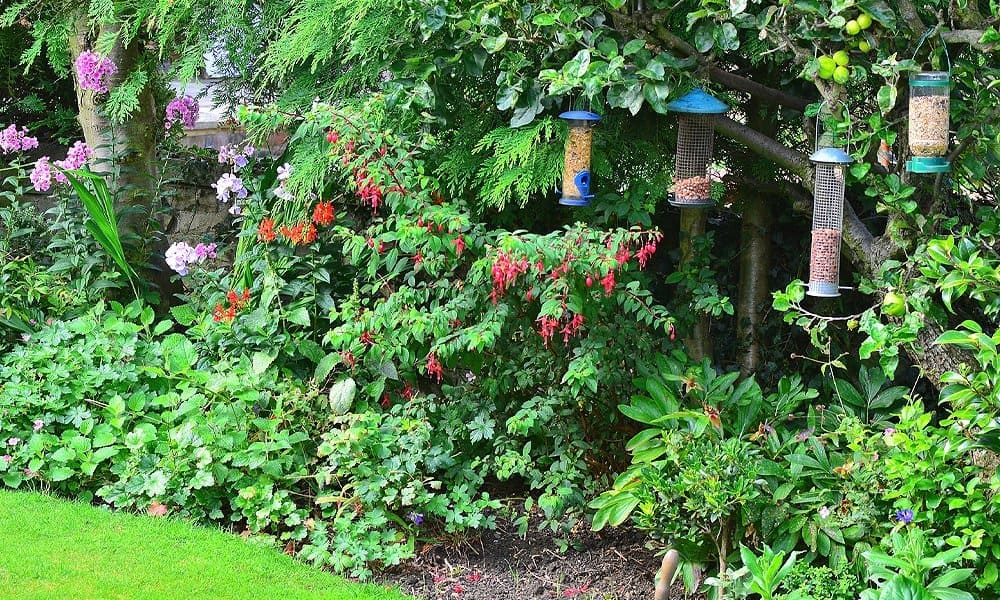
You'll want to consider placing your station somewhere you can view it year-round, and in the safest space for your birds. Different species of birds feed at different levels and the perfect feeding station will match this.
Start with at least 3 or 4 feeders, placing them at different heights, with a variety of feeder types, giving you the best chance at attracting birds to your yard. The more feeders you have, the more birds you will attract.
2. Tempt with the right treats
With a variety of different feeders, you are on the right track to attracting a gaggle of birds to your yard. Tempting birds with the right treats is another excellent step in meeting their needs and providing a safe haven for them. Different birds eat different things, so giving them a choice is not only a tool to entice them but also helps them get the proper nutrition they need to stay healthy.
One of the biggest mistakes that beginners often make is buying cheap food or generic low-quality feed like those typically found at large chain hardware stores or grocery stores. While it's a start, help your birds stay healthy by investing in quality bird feed that meets their nutritional needs and is best suited for them.

Black Oil Sunflower seed is an excellent place to begin and will attract a variety of songbirds, including Blue Jays, Cardinals, Grosbeaks, and chickadees. But don't stop there – offer your birds a variety of seeds and berries to appeal to the widest array of wild birds. Smaller seeds like nyjer or millet will attract different species, like nuthatches and finches, that aren't as big a fan of sunflower seeds.
Suet cakes are also an excellent choice that many birds will make use of, especially those that need high-energy food that is easily digestible like woodpeckers, chickadees, and wrens (1). In addition to seed and feed varieties, many birds will delight in other treats such as peanuts, nuts, and nectar. Pair each with the proper feeder and you'll be sure to tempt a wide range of species.
3. The location of the feeder is the key
When trying to attract a wide variety of birds to your yard, the location of the feeder is key. Different birds display different behavior when it comes to visiting feeders. While some birds prefer to swoop in from across the yard, making a clear shot right to the perch, others will be put off by a feeder that's too exposed.
Try placing your feeders in a variety of different areas to appeal to different bird preferences. Birds like Cardinals have been known to be shy and like some form of natural cover. Try placing one or two feeders near a large shrub or bush that offers them the protection they crave.
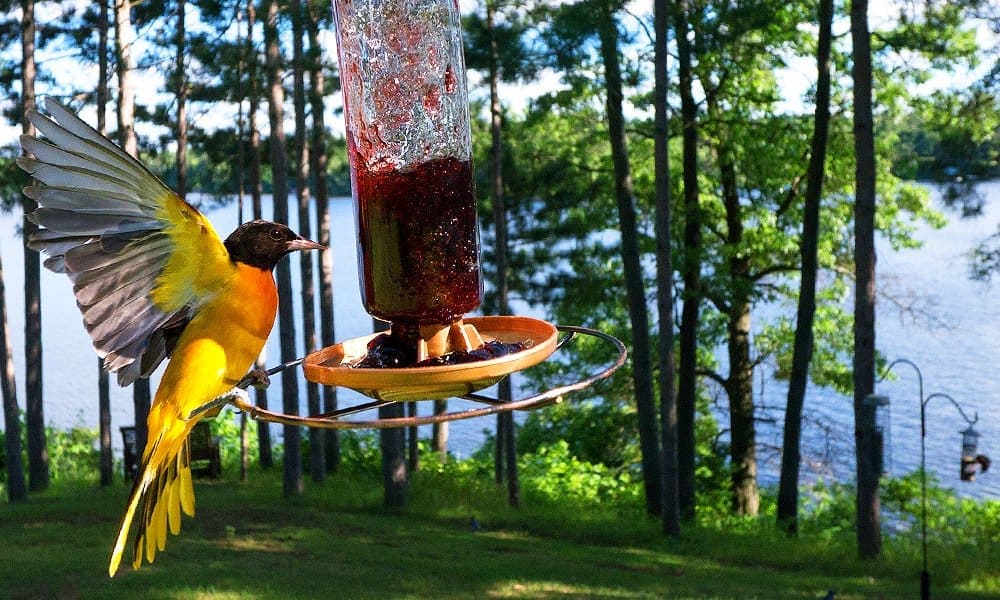
Feeder placement should be off the ground and at a significant height, so birds don't become sitting ducks for backyard predators like cats. Keep in mind that some birds can become territorial about feeders. To combat this behavior, place feeders at least 3 to 4 feet apart to give birds the space they need.
Deter pests such as squirrels from taking over your feeders by using baffles, or other barriers as well. The safer birds feel while visiting your feeder, the more likely they are to keep coming back. Giving birds a place to rest, perch, and sit while they eat will make them feel both safer and more comfortable using your feeder.
4. Install a bird bath
Attracting birds to your yard is more than just providing a reliable food source. All birds need water, so install a bird bath to lure more birds to your yard with a water source.
While a basic birdbath is a great start, upgrading your birdbath and water features is a sure way to attract more birds – for example solar bird bath. The sound of moving water is magnetic to most wild birds and curious species will come to investigate even from great distances.

Adding movement to a stationary bird bath is as simple as installing a mister, dripper, or circulating pump. If resources permit, consider adding an even bigger feature, such as a waterfall or pond, to attract even more birds with the lure of water.
A stable water source will be a big draw and a single source may become crowded, so consider multiple water sources or several bird baths to attract more birds. By doing this, you can create different water environments, like static, moving, or even misting, to appeal to different species.
Related: 9 Best Heated Bird Baths to -30°F [to Unfreeze Water]
5. Seek attention with bright colors
Birds are naturally attracted to bright colors, so pique their attention by offering a variety of colors around your yard. Like us, birds are one of the few animals that can see in color and they rely on it in a variety of ways (2). From attracting a mate to hiding from predators and almost everything in between, color can play an important role in a bird's existence.
Make your yard especially enchanting by the placement of colors known to attract birds. Red is especially known to attract hummingbirds and many feeders come in a bright red hue to catch their eye. While orange and yellow have been known to attract Orioles and Goldfinches and feeders specific to them often come in these hues.
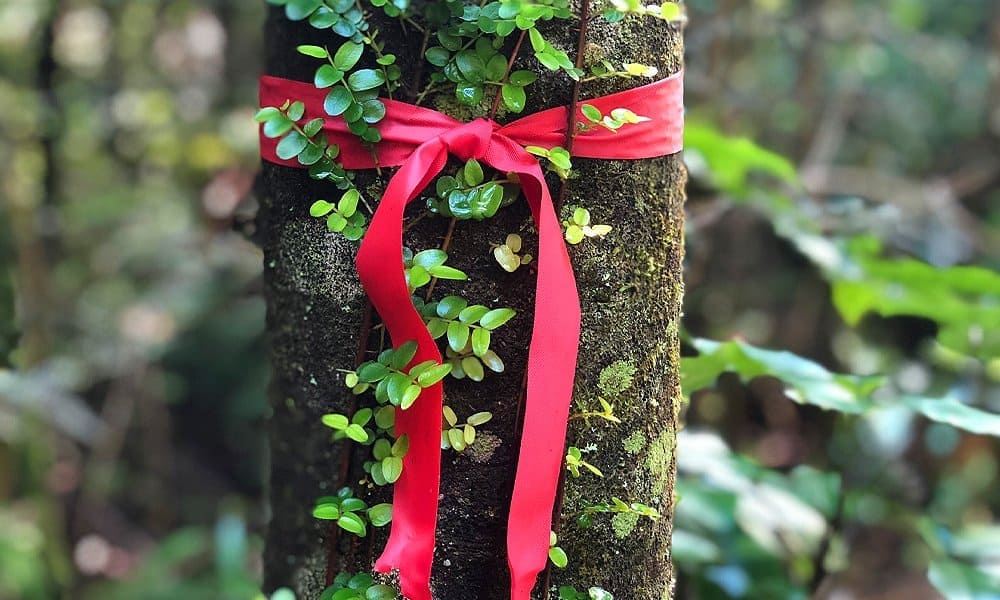
In general, birds are attracted to their own color, so incorporating blue items into your yard, either through feeders or other decorative items, is sure to attract Blue Jays and other bluebirds. Adding color can be done in a variety of ways from artificial installments such as bird feeders and houses, to planting naturally vibrant shrubs and flower varieties attractive to birds.
Birds will always be most attracted to those colors associated with foods they eat, so planting native trees and species of plants will not only entice birds to see what your yard has to offer but will provide a much needed environmental wonderland for your birds.
6. Install a bird house
The shelter is a key factor in making birds feel safe and more likely to make your yard their home. Install a birdhouse to entice birds to stay, by providing safe and reliable shelter for them. Of course, not all birds like birdhouses, but those that do have different needs and preferences depending on the species.
More common occupants of birdhouses include sparrows, chickadees, and bluebirds, but many species will use a birdhouse, so choose the size and type depending on the type of birds you want to attract. In general small birds like small houses and large birds will use large houses.

If you want to attract chickadees, wrens, or other small birds, an 8-inch tall house, with a 4 by 6 or 5 by the 5-inch base is generally acceptable while the larger the bird, the larger the house it will need, with owls needing houses as large as 24 inches tall with a 10 by 10-inch base (3). In addition to the size of the house, an important aspect of selecting the right house includes the size of the entrance hole.
Follow the adage above regarding size, and check breed-specific requirements for the specific birds you are trying to attract. And lastly, installing location is important when it comes to birdhouses. Install your birdhouse in a safe location, high enough off the ground to encourage birds to find safety in their house.
7. Encourage nesting in your yard
There are a variety of ways to encourage nesting and attract birds to raise their family in your backyard. Not all birds will make use of birdhouses, but there are many other ways to encourage nesting in your yard.
Offering materials that birds use when constructing their nests, such as string, pet fur, hair, and yarn in a suet cage feeder, is one way to help with construction and make your yard an attractive nesting site. Many birds will make use of these implements to help in the building of their nests, while others will take advantage of natural offerings around your yard.

The weed fluff from dead flowers, grass clippings left on the lawn, and brush piles can all provide much-needed nesting materials to aid with the build.
Birds face growing threats from lack of adequate shelter and nesting sites, so you can also help by planting native shrubs, trees, and flowers that encourage nesting. Plants native to their environment are more specifically adapted to the weather of that climate and provides the best natural nesting site to attract birds into your birdscape.
8. Install a perching stick
All birds need a place to rest, preen, or simply take in the landscape. If your yard doesn't offer natural structures such as trees or bushes, install a perching stick to create a safe place for your birds to rest.
Whether birds need to stop and take a break from their migratory activities, or they're looking for a spot to preen their feathers, installing a perching stick offers them this much needed safe space. Birds often use perches to scan the area and assess danger, making a decision about the safety of the feeder as well.

Native trees and landscaping are always best, but perching sticks can be used when these aren't available. Don't place them too close to feeders, though, as it may give predators an unnecessary advantage. Perches can be made from a variety of materials, or you can use old branches to mimic a more natural setup.
One of the added bonuses of installing a perching stick is that you can set it up in the perfect environment (i.e., lighting and background) to capture a great image. Consider this when determining the location, materials, and size of your perching stick.
9. Create a bird-friendly landscape
Perhaps one of the best ways to attract birds to your backyard is to create a bird-friendly landscape for them to enjoy. Birds need food, water, and shelter to fulfill their basic needs, and you can help by planting native trees, bushes, and flowers that create this habitat for them.
They won't come to an empty yard, so with a bit of basic planning, you can design a space that not only meets their needs but has them coming back for more, providing you both with years of enjoyment.
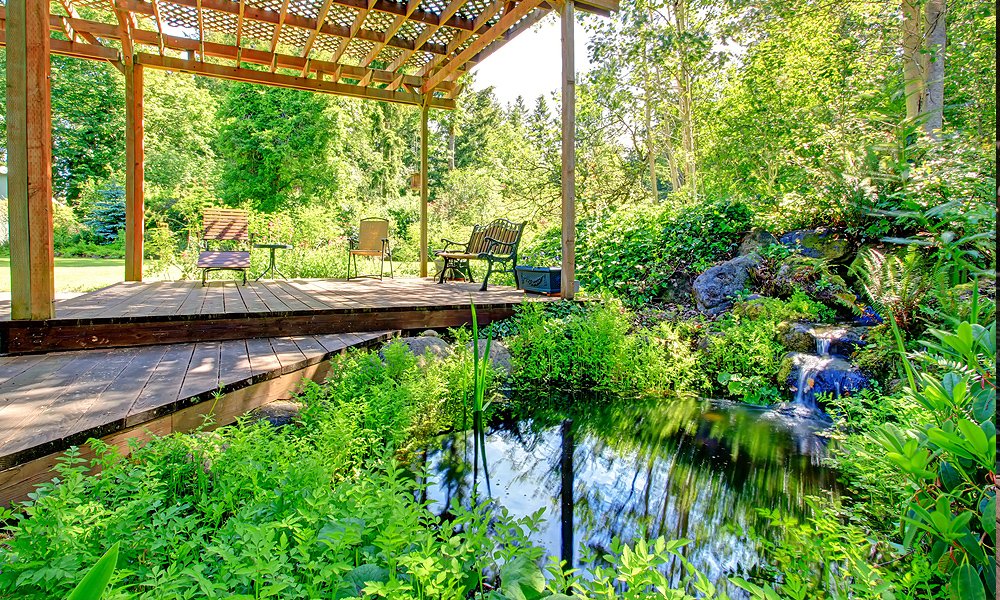
Consider increasing the density of your existing plants and shrubs to create more cover and nesting sites for birds or spruce up unused areas of your yard with bird-friendly grasses and flowers. Even those lacking the space or resources to plant anew can offer our feathered friends a habitat by way of a container garden.
Native plants are most beneficial as they are best adapted to the weather extremes of your local climate. Whether in your yard or through container gardening, selecting a mix of species will provide the best variety in terms of offering different habitat layers for your birds and enticing them to your birdscape.
10. Squirrel-proof your bird feeders
When it comes to attracting birds, there is one pest you will surely have to contend with – squirrels. While you may want some squirrels in your yard, they can quickly become a nuisance and stage a hostile takeover of your feeders.
Squirrels have been known to have voracious appetites for bird seed and together with their athletic ability, they present quite the challenge for backyard bird watchers. There are several strategies you can employ to squirrel-proof your feeders. Feeder designs have come a long way and you can find a variety of squirrel-proofing options on the market.

Some are weight-balanced to throw the squirrels off, while others simply put a barrier, such as a wire mesh, between the food source and the curious critter. Other deterrents include installing a baffle on your feeder pole or using homemade remedies like bacon grease on the pole to prevent them from getting enough grip to make it to the feeder.
This method, while somewhat rudimentary, has the added bonus of being entertaining watching the squirrels try to figure out why they can't make it up the pole and slowly sliding back down. Of course, feeder location also plays a critical role. The more easily accessible to squirrels, the more likely you will be to wage war on these inquisitive rodents.
Related: 12 Tips on How to Keep Squirrels OUT of Bird Feeders
11. Keep your feeders clean (inside and outside)
One of the most often overlooked tasks when it comes to attracting birds to your backyard is feeder maintenance. Birds will avoid a dirty or unclean bird feeder, so regular cleanings are a necessity.
All feeders need to be cleaned regularly to reduce the chance of spreading disease and parasites where birds congregate, keeping your birds safe and healthy. If you notice a drop in feeder attendance, the seed may be wet or moldy and, therefore, unattractive to your feathered friends.
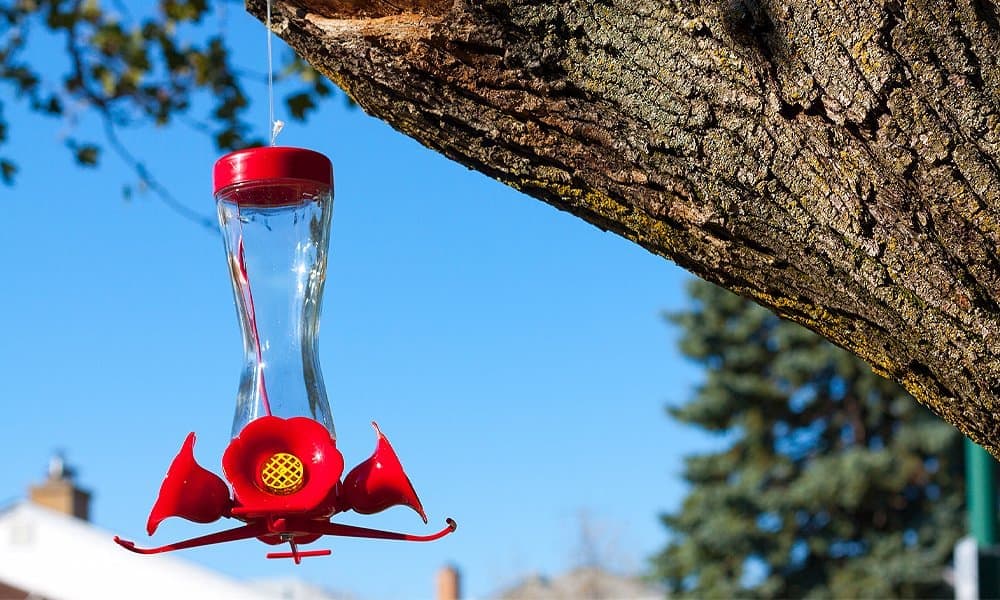
Regularly cleaning your feeder will not only prevent the spread of disease but will give you a chance to discard any unused or moldy seed that is bad for the birds.
Feeders should be regularly checked and washed with a mild mixture of dish soap, dilute bleach, and warm water and left to dry before being refilled. To minimize the risk to ground-feeding birds, clean up hulls and spilled seeds underneath feeders or any area birds congregate.
12. Lure them with the right plants
The best way to lure birds to your yard is with the right plants. Attract local birds with the species they are most familiar with as rich food sources and appropriate shelter.
Native plants, trees, shrubs, and flowers will not only be most beneficial to the local climate. They will provide a familiar place for your feathered friends. Consult online plant databases to see what works best for your area or visit your local nursery to speak to an expert.

Not only are native plants better suited to attract more birds, but they require less maintenance because they are uniquely adapted to the local climate. Selecting a mix of plants to fill a variety of needs will give you the best chance at enticing birds to your yard.
Seed-producing flowers and plants are a welcome food source, while thorny bushes like hawthorn or raspberry offer beneficial nesting sites. Of course, evergreens and berry-producing shrubs are also beneficial flora when it comes to creating the perfect backyard birdscape.
richardforkildney.blogspot.com
Source: https://worldbirds.com/how-to-attract-birds/
0 Response to "How Can I Draw Birds to Feed at My Feeder"
Publicar un comentario